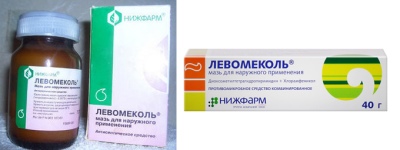Ointment "Levomekol" for children: instructions for use
Levomekol has long established itself as an effective local antibacterial agent.
Simultaneously with the impact on harmful bacteria, this ointment accelerates the regenerative processes, as a result of which wounds are cleaned and heal faster. Especially often the drug is used by surgeons, because Levomekol helps with purulent wounds and promotes the healing of sutures. Is it possible to use such a medicine in childhood and when it is prescribed to children?
Release form and composition
The drug looks like a white or white-yellowish homogeneous mass of medium density, packed in a polyethylene or aluminum tube in an amount of 30, 40 or 50 grams. Each tube is placed in a carton box with instructions.
The action of Levomekol is provided by two active compounds:
- methyluracilpresented in 1 gram of ointment dosage of 40 mg. This substance is also called dioxomethyl tetrahydropyrimidine.
- chloramphenicol, which in 1 g of the drug contains 7.5 mg.
Additionally, there is macrogol 1500 and 400 in the medication, thanks to which the ointment is easily applied to the skin and penetrates into the tissues. There are no other compounds in the medication.
Operating principle
The components of Levomekol, after applying the medicine to the skin, easily penetrate into the infected tissues and have an antimicrobial effect. Chloramphenicol in its composition affects many gram-positive and some gram-negative bacteria. It is effective against E. coli and staphylococcus, as well as when infected with Pseudomonas aeruginosa.
Thanks to methyluracil, Levomekol stimulates the regeneration of damaged tissues. This component stimulates the formation of new cells and restores their normal structure. It also removes excess fluid from the tissues, which leads to the elimination of puffiness. In addition, methyluracil has the ability to activate the production of interferon.
The simultaneous effects on pathogenic bacteria and the anti-edema effect provide the anti-inflammatory effect of Levomekol. In this case, the ointment does not damage the cells that did not hit the bacteria, and it works even if there is necrotic masses and pus in the wound.
Indications
Treatment with Levomekol prescribed with the appearance of purulent wounds. It is recommended to lubricate the infected skin from the very beginning of wound formation, when there is active inflammation, exudation, pus formation and tissue breakdown. In addition, the ointment is in demand:
- With panaritiums, boils, dermatitis, streptoderma and other purulent skin diseases.
- With external purulent otitis.
- With severe burns.
- With trophic ulcers.
- When balanoposthit.
- When inflammation of hemorrhoids and anal fissures.
- With purulent rhinitis, adenoids and sinus.
For the prevention of the drug is used for cuts, surgical sutures, bedsores, scratches, chicken pox, weeping eczema, puncture wounds, diaper rash and other skin damage. Such treatment accelerates healing and prevents infection.
Sometimes Levomekol is recommended for “cold” on the lip, but this problem is caused by the herpes virus, so with it the remedy is ineffective. In addition, the child may lick his lips, which will lead to undesirable ingestion of ointment, and the taste of the drug is bitter.
At what age is it allowed to take?
Levomekol is not used in children younger than a year, as in the body of infants, the biological transformation of one of the active compounds of the ointment is slower, which can have a detrimental effect on the baby.
Contraindications
Levomekol is not used in children with allergies or hypersensitivity to any ointment ingredient. Any diseases, including chronic pathologies, are not a contraindication to local treatment with such a drug.
At the same time it is necessary to prevent the ingestion of the drug inside or into the eyes. If a child accidentally swallows the ointment, it is recommended that the stomach be washed and the activated carbon intake be taken, and if Levomekol gets into the eyes it is necessary to wash the conjunctiva with a large volume of pure water.
Side effects
The drug is considered low-risk, since it acts mainly locally. However, occasionally treatment with Levomekol can cause an allergic reaction, for example, in the form of skin rashes.
Instructions for use
The drug is used externally, lubricating the affected area with a thin layer of Levomekol, after which the skin is covered with gauze or a piece of clean fabric. Treat the infected surface every day once or twice until it is completely cleansed of purulent secretions and wound healing begins. This most often occurs by 5-10 days of using Levomekol.
With fairly deep wounds, the drug is applied to gauze laid in several layers, and then such a napkin is placed into the wound cavity. Such a filling should not be dense, but rather loose. Damage should be treated daily until the necrotic and purulent masses are completely removed from the wound.
If purulent inflammation is revealed in a small patient in the outer part of the ear canal, then thin flagella are impregnated with a bandage with Levomekol. They are shallowly laid in the ear before bedtime and left overnight. The same method of application is prescribed for sinus, but flagella with ointment are inserted into the nasal passages. When purulent rhinitis, the drug is applied to the mucous membrane 1-2 times a day with a cotton swab.
Boils and purulent acne are treated with Levomekolom two or three times during the day, and then also at night. The medicine is applied on them in a thin layer. When the abscess has opened, the wound should be washed with an antiseptic (hydrogen peroxide, chlorhexidine or other), and then continue lubrication with Levomekolom twice a day until the damage is fully tightened and the integrity of the skin is restored.
Overdose and drug interactions
Cases of overdose of Levomekol, according to the manufacturer, have not been identified until this time. The drug did not cause intoxication or any side effects even when processing a large area of skin, for example, with burns.
On the incompatibility of Levomekol with other medicines, there are no data in the abstract either, but doctors do not advise to mix the ointment when treating the skin with any other external means.
Terms of sale and storage
Lekomekol is an over-the-counter medicine, therefore it is freely sold in pharmacies. The price of one tube with 40 g of ointment varies from 100 to 120 rubles.
The manufacturer recommends keeping Levomekol at home at a temperature of less than 20 degrees Celsius. The tube should be kept in a place hidden from the kids. Shelf life ointment is 3.5 years. After its expiration, the use of medicine is unacceptable
Reviews
Almost all parents praise Levomekol and confirm the high efficacy of such an ointment in children with boils and purulent wounds, with finger festering, burns, otitis, and many other diseases. According to moms, treatment with the drug significantly speeds up the healing of any injuries, which is especially appreciated in children, because children have scratches, wounds, cuts, abrasions and other skin damage are very common.
Analogs
A completely similar in composition medicine that can replace Levomekol is Levomethyl ointment. One more analogue can be called Levosin ointment, but in addition to chloramphenicol and methyluracil there are two more active compounds - local anesthetic Trimecain and antibacterial substance sulfadimethoxin.
Due to such components, the drug more actively destroys harmful bacteria inside purulent wounds, anesthetizes and improves healing.
In the next video you can learn more about all the medicinal properties of Levomekol ointment.






























